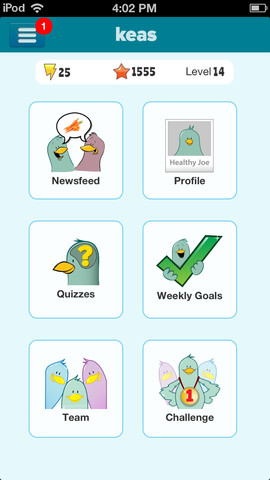Clinical laboratories have an opportunity to provide medical laboratory test services to employer-sponsored wellness programs
Venture capitalists are beginning to pour dollars into mobile apps designed to support corporate health and wellness. For savvy pathologists and clinical laboratory managers, this represents an opportunity to serve a cash-paying market for medical laboratory testing.
Another aspect of this trend which may be worth studying by pathologists and clinical laboratory administrators is the use of “gamification” by these mobile app developers. Gamification uses technologies and programming to more deeply engage the user, just as a video game does.
Corporate wellness platform Keas of San Francisco, California, recently announced an $8-million investment round, according to a story at mobihealthnews.com. Ignition Partners and Atlas Ventures provided the capital. With this latest round of funding, investors have $25.5 million invested in Keas.
Wellness App Developer Uses Gamification as a Strategy
Keas was founded in 2009 by Google Health veteran Adam Bosworth. The purpose of the program is to engage employees and encourage them to participate activities that support their health.

Shown here is one screen shot of the corporate wellness mobile app developed by Keas. This is an example of how corporate health and wellness programs are evolving in ways that create greater engagement of employees who are participating in these programs. Because many chronic health conditions require clinical laboratory testing as one tool to help patients manage their disease, some experts believe that medical laboratories have a good business opportunity to serve corporations that have health and wellness programs for their employees. (image copyright Keas.)
First iterations of Keas, however, did not sufficiently engage users, according to the mobihealthnews.com story. “It was technically accurate, but very boring,” observed Josh Stevens, Keas CEO since 2012. “We want to make health social and mobile and really engaging for employees,” he declared.
Applying Game Design to Non-Game Apps
After several major pivots, Keas used gamification to enhance its appeal to users, a story at gigaom.com reported. According to gamification.org, the concept involves applying game design thinking to non-game applications. Several industry experts have labeled gamification one of the most important trends in technology.
For example, Keas emphasizes three things to gamify exercising, according to a Gamification Corp. synopsis. They are:
1. game mechanics;
2. social interaction; and,
3. small groups.
Players accrue points and status, which drives positive reinforcement in the game mechanics. To interact socially, small teams six participants use competitive statistics and community Q&A forums. If a team member stops participating, the entire team is unable to play. This brings social pressure to bear to encourage all participants to exercise.
Average Employee Visits Mobile App Site 12 Times Each Month
The average employee engages with the site 12 times a month, according to Keas. This is significant, because it is about triple the number of times the same users visited the existing wellness sites of client companies before they introduced the Keas wellness app. The existing wellness sites are portals usually offered by health plans.
Keas is available as a mobile app. It is expanding its functionality by integrating with other health and wellness applications. For example, the program recently integrated with Fitbit and Runkeeper.
Keas also plans to partner with the health coaching platforms GAIN Fitness and meQuilibrium. Pathologists and clinical laboratory professionals will be interested to learn that Keas will also partner with Laboratory Corporation of America (NYSE: LH), which provides medical laboratory tests, biometrics and health assessment.
Hospital Case Study Shows Benefits of a Wellness Mobile App
“At Chilton Hospital, a non-profit hospital with 1,300 employees, 40% of eligible employees registered for the Keas challenge,” Keas officials stated in a press release announcing the 2011 investment round. “In addition to the 1,230 pounds Chilton Hospital employees shed during the 12-week challenge, 73% of Keas players reported feeling more positive towards their employer and 64% thought the experience made them more productive at work. By the end of the Keas challenge, 88% of players reported that they would remain proactive about their health as a result of the program.”
Wellness Programs Lower Healthcare Costs, Increase Productivity
The typical employer pays an average of $10,000 per year per employee for healthcare, according to a story published at venturebeat.com. Stevens further observed at the 2013 HealthBeat conference that 70%-80% of healthcare costs are preventable.
“It is in employers’ best interests to motivate their employees to do the right thing,” he said. “Health care costs are rising, and every time an employee takes personal time off to visit a doctor or fill a prescription can result in $250-$500 in productivity costs. The productivity savings of healthy employees are huge.”
Wellness Startups Shifting to Direct-to-Employer
The workplace wellness market could be worth from $2.7 billion to $8.2 billion per year, according to a story in Venture Beat. Employers reach about half of the world’s population.
Another driver in the United States is the Affordable Care Act. It will enable insurance companies to directly reimburse wellness programs at a higher rate than ever before, reported another Venture Beat story.
Pathology groups and clinical laboratory managers might want to think about how to directly approach major employers in their communities to provide wellness testing. Similarly clinical laboratory managers may want to explore how to use mobile apps to create more engagement with their patients.
—Pamela Scherer McLeod
Related Information:
Keas raises $8M, partners with Fitbit for gamified employee wellness
Jiff pivots to employee wellness curation
Workplace wellness startup Keas raises $6.5M
Keas raises $8M to get employee to exercise and eat more veggies
Keas jogs out new-and-improved tools to promote employee health
Wellness startups find a channel to better health: Employers



